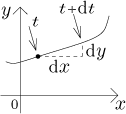Theorem.
Consider a parametric curve given by
Assume that f and g are differentiable at some
t0 from the interior of I and that
Moreover, this function is differentiable at
![]()
Consider a parametric curve given by
x = f (t),
y = g(t) for t from an interval
I, where f and g are continuous functions.
Consider also a point
This condition means that f is either increasing or decreasing at
t0, therefore at that time the curve moves left or right as
it passes through the given point. The theorem asserts that we can describe
the curve using a function there. We can imagine that the function f
is actually
see Parametric
functions in Functions - Theory. If we assume that f and g
are differentiable at t0, the whole function on the right
is differentiable, therefore also
Theorem.
Consider a parametric curve given by
x = f (t),
y = g(t) for t from any interval I.
Assume that f and g are differentiable at some t0 from the interior of I and thatf ′(t0) ≠ 0. Then there is some neighborhood of t0 on which the corresponding part of the curve can be expressed using a functiony = y(x).
Moreover, this function is differentiable atx0 = f (t0) and we have
We used functions f and g instead of writing the traditional
![]()
It gets even more interesting when we use the Leibniz notation.

Now it looks like ordinary cancelling, so the Leibniz notation again makes things look natural.
Note the interplay between time and spatial reasoning. We can view this curve
as an ordinary object in the plane, or we can view it as a record of some
movement in time. When we want derivative with respect to the
Having the formula for the first derivative, we can differentiate it once more to get the following.
Theorem.
Consider a parametric curve as in the previous theorem with all the properties listed there. Assume moreover that f and g are twice differentiable at the t0. Then the functiony = y(x) is also twice differentiable atx0 = f (t0) and we have
Using the traditional notation for a parametric curve we get
![]()
How did we get this result?

Then we just substitute in x0, use
Example: Consider the parametric curve
Prove that on a neighborhood of
Solution: The time corresponding to the given point is
![]() (1) = 2e,
(1) = 2e,
By the above theorem we also have

We know how to differentiate a local spatial description, now we return to
the problem of decomposing a given curve into parts that can be expressed by
functions. We know that changing parametric equations into a function is done
by elimination, for which we need the function
Assume that we can split the interval I into subintervals on each of which
the derivative ![]() (t)
(t)
Note that the sign of the derivative ![]() (t)
(t)![]() (t) > 0,
(t) > 0,![]() (t) < 0,
(t) < 0,
For a review and an example of parametric curves see Parametric functions in Methods Survey, there is also an example in Solved Problems - Parametric functions.
Now we return to where we started. The whole point of this section has been to forget about moving around and reduce parametric curves to pictures and functions. We were quite successful, in fact in the next section we learn how to sketch parametric curves. But now we leave this topic and ask what other information can be deduced from a parametric curve.
Given that a parametric curve is a record of a movement, one natural question is about the instantaneous speed at any given point. We have a formula for that.
![]()
How do we get it? Assume that a bug is at time t at some place and then moves by time dt. In space this means movement by dx and dy, but since x and y are functions of t, we get transformation formulas
![]() ⋅dt,
⋅dt,![]() ⋅dt.
⋅dt.
(See Leibniz notation in Theory - Introduction.) Since we moved by an infinitely short time, the curve did not have time to bend and we can think of it as a straight line.

Thus the change ds in position s can be calculated using the Pythagorean rule:
![]()
When we divide by dt, we get the desired equality, since speed is exactly the time derivative of position.
We can learn more, for instance we can calculate the length of the path taken, but that requires integration; we refer to Curve length in Integrals - Theory - Applications. In Area in Integrals - Theory - Applications you find how to calculate the area of the region given by a parametric curve, there are also some tidbits about the center of gravity.
Sketching parametric functions
Back to Theory - Implicit and parametric
functions